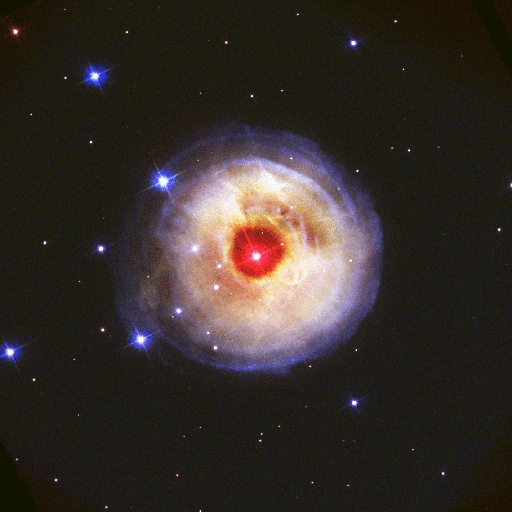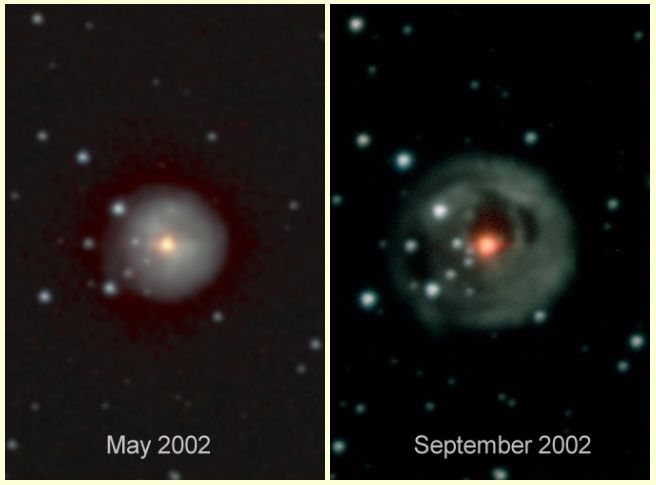
Posted on 05/03/2003 12:33:42 AM PDT by Swordmaker
STARS ESCAPE FROM ASTRONOMICAL ZOO
Don Scott
The Astronomy Picture of the Day (APOD) site has run several discussions of the "variable star" V838 Monocerotis. Today they have another one.
Astronomy Picture of the Day - V838 Monocerotis
but also see
Astronomy Picture of the Day - V838 Light Echo: The Movie
They include comments like, "V838 Mon may be a totally new addition to the astronomical zoo."
I object to this "new" characterization. This zoo animal disproves standard fusion models. In fact this star (together with several others) simply demonstrates stellar evolution wholly NOT in keeping with thermonuclear stellar theory. To paraphrase my web page:
FG Sagittae breaks all the rules of accepted stellar evolution. FG Sagittae has changed from blue to yellow since 1955!
V605 Aquilae: Examination of old images and spectrograms reveal that V 605 Aquilae, studied by Knut Lundmark in the 1920's was a similar sort of beast,...
V4334 Sagittarii is better known as Sakurai's object, for its 1994 discoverer. It, too, changed both spectral type and surface composition very rapidly, and is now hydrogen-poor and carbon-rich, and well on its way to becoming the century's third new R CrB star.
So now there are at least four prime examples of stars that do not evolve according to the accepted thermonuclear model of how stars are powered. THESE CHANGES HAVE ALL BEEN OBSERVED DURING THE LAST FEW YEARS. These are stars that falsify the conventional understanding of stellar life cycles. All of them act in a manner predicted by the Electric Star hypothesis.
If we trust ancient observers of the sky (our group is based on doing exactly that, is it not?), then there are three additional stars that have changed ("evolved") during the last couple of millennia.
Sirius is a main sequence, brilliant white A-type star. The ancients (among them: Cicero, Horace, Ptolemy, and Seneca) called it red or "coppery" in color. Seneca, in the days of Nero, called it "redder than Mars", whereas he described Jupiter as "not at all red."
Castor is designated as the alpha star in the constellation of Gemini, but it is not as brilliant as the beta star, Pollux. Stars in constellations are always named alpha, beta, gamma, etc., in decreasing order of apparent brilliance. Castor is the 23rd brightest star in the sky while Pollux is the 17th brightest. It has been suggested therefore that since the time of the ancients, Castor has lost luminosity.
Capella was described as being a "red star" (we would call it M-type) by several ancient and medieval writers including Ptolemy and Riccioli. It has now been confirmed to be a binary - one G-type and one F-type. Not M-type.
In the Electric Star version of "stellar evolution" things can happen quickly. If the fusion model were correct, it would take hundreds of thousands of years for a star to change from one place in the HR diagram to another. It would not be observed within a "human lifetime", or have been observed over an astronomically relatively short period of a mere, say, 2000 years.
It didn't take FG Sagittae hundreds of thousands of years to "run down." The star V838 Monocerotis has moved half way across the Hertzsprung-Russell diagram in a few months. Migrating across the HR diagram can happen very rapidly - and apparently does! How many such counter-examples does it take for astrophysicists to realize their stellar fusion theory has been falsified?
Don Scott
Again, sorry for being off so much lately.

Although European records were sparse during the Dark Ages, skywatchers in the Far East recorded transient objects they observed in the sky during that era. There is a list of transient objects in the General Catalog of Variable Stars, Volume III, (Moscow, 1973). The list covers sightings recorded between 2296 BC and 1690 AD.
The list is in places ambiguous because of difficulty in determining the precise location in the sky of some of the objects recorded; however, when the subject is Sirius, the brightest star in the sky, one is tempted to believe those ancient stargazers would have had no difficulty in pinpointing it for us.
Bear that in mind as I reveal that my review of the list turns up no reports of the brightening of Sirius or of the appearance of a "guest star" in its immediate vicinity.
Still, it is possible that a brightening of Sirius or the Pup could have been missed, if for example it occurred during a time when Sirius was lost in the sun's glare (Dog Days) and for a duration measured in days, not weeks or months.

Alternate theory .... someone's building a Dyson shell.
That would be the biggest news since the Resurrection.
Physics News UpdateTHE SOLAR NEUTRINO PROBLEM PERSISTS. The "standard solar model" predicts that the Homestake neutrino detector, operated for 20 years by Ray Davis in a South Dakota gold mine, should observe an average of 1.8 solar neutrinos per day. Instead Davis' observed rate has consistently been much lower than this. Furthermore, the long-term rate, plotted as a function of time, shows an anticorrelation between neutrino rate and sunspot activity. The "solar neutrino problem" has in recent years been tackled by two other groups, and they too record puzzling results. Over a three year period the Kamiokande II detector in Japan sees a neutrino rate about half that expected by the standard model, roughly equal to Davis' average rate for the same period, but without the time variation seen at Homestake. Unlike Kamiokande and Homestake, which are sensitive only to the relatively high-energy neutrinos released in the beta decay of boron in the sun, the Soviet-American Gallium Experiment (SAGE) in the Caucasus (USSR) is designed to observe the lower-energy neutrinos coming from the more plentiful proton-proton fusion reactions in the sun. In five months of running, SAGE has observed essentially no neutrinos at all, further deepening the mystery. Some theorists believe that one explanation may be that solar neutrinos may be "oscillating" from one neutrino type (electron, muon, tau) to another on their way to the earth and thus evading detection. Meanwhile a fourth detector, Gallex, located in Italy, will soon begin operations. (Physics Today, October 1990.)
by Phillip F. Schewe and Ben Stein
October 11, 1990
Bulletin of Physics News
American Institute of PhysicsPhysics News UpdateNEUTRINO MASS AND SOLAR NEUTRINO UPDATE . At the Moriond neutrino meeting held in February in Switzerland, the latest neutrino mass limits reported were 8 eV for the mass of the electron antineutrino (a Livermore result) and 7.2 eV for electron neutrinos (Mainz). Both limits were established in tritium beta decay experiments. As for the solar neutrino problem, a combination of results from the two gallium detector groups, SAGE (former Soviet Union) and GALLEX (Italy), gives a measured flux value of 72 solar neutrino units (one SNU equals 10**-36 neutrino captures per second per detector target atom). This is still low compared to the standard solar model prediction of 125-132 SNU. (CERN Courier, June 1993.)
by Phillip F. Schewe and Ben Stein
July 1, 1993
Bulletin of Physics News
American Institute of PhysicsPhysics News UpdateSOLAR NEUTRINO FLUXES VARY WITH A PERIOD OF 21.3 DAYS. This is the conclusion of Stanford scientists Peter Sturrock and Guenther Walther who examined years' of data from the Homestake (South Dakota), Kamiokande (Japan), and GALLEX (Italy) neutrino detectors. Hypothetical causes of the periodicity include the rotation of magnetic fields inside the sun or a variability in the production of neutrinos in the solar core. (Science, 20 Sept.; New Scientist, 21 Sept.)
by Phillip F. Schewe and Ben Stein
October 3, 1996
Bulletin of Physics News
American Institute of PhysicsNeutrino mass discoveredThe SuperKamiokande result could also be important for big bang theory, which predicts that the universe contains a large background of neutrinos. If the neutrino mass was 1 eV, this would suggest that neutrinos account for more mass in the universe than all of the protons and neutrons put together. Neutrinos would therefore represent a significant amount of "dark matter", mass that we cannot see but is predicted to exist by cosmological models. The simplest interpretation of the solar and atmospheric results is that the heaviest neutrino has a mass of 0.1 eV. However, neutrino oscillations depend only on the differences in mass, so it is possible that all three masses are 1 eV or greater but that the mass differences are much smaller. Thus it is not clear how this new evidence relates to the dark matter problem.
Physics in Action
July 1998
Physics World
FR Lexicon·Posting Guidelines·Excerpt, or Link only?·Ultimate Sidebar Management·Headlines
Donate Here By Secure Server·Eating our own -- Time to make a new start in Free Republic
PDF to HTML translation·Translation page·Wayback Machine·My Links·FreeMail Me
Gods, Graves, Glyphs topic·and group·Books, Magazines, Movies, Music
Disclaimer: Opinions posted on Free Republic are those of the individual posters and do not necessarily represent the opinion of Free Republic or its management. All materials posted herein are protected by copyright law and the exemption for fair use of copyrighted works.